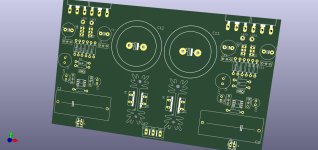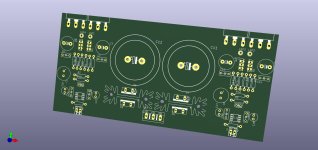Sioux
Here is a higher power version of Choctaw.
Output 26 Watt with +/-25VDC supply.

Here is a higher power version of Choctaw.
Output 26 Watt with +/-25VDC supply.
Last edited:
We need dc-servo?
What for? The opamp in the circuit seems quite capable of maintaining a low offset at unity dc gain.
No, we need not.We need dc-servo?
The opamp will keep DC-offset very low. One or a few mV.
I was thinking about the diodes.Here we go again ...
Can we use 'normal' diodes. Not TO-220.
That way we can skip the heatsinks.
I changed some resistor values. See the new schematic in post#1.
But the circuit is the same.
this is just a quick visualization
I'm busy with other projects now
Maybe I'll come back to this amplifier in some time
I'm busy with other projects now
Maybe I'll come back to this amplifier in some time
While I don't doubt this is a simple and very good little amp, seems kinda like cheating putting an op-amp in front of a basic output stage?
Although I have been working on an output stage that would be perfect for this application, but probably overkill.
Have you got any THD and FFT readings?
Although I have been working on an output stage that would be perfect for this application, but probably overkill.
Have you got any THD and FFT readings?
I think the simpler, the better. I would build the thing and test it both with and without OPA. It may well be that most people have enough juice in their sources, such as DACs or CD players, to drive it without any problems. Just try it out. This would be a very good basis for many experiments. To diy audio;-)
Absolutely, when the diamond transistors operate in close thermal contact, the input transistors stabilize the idle current of the output pair, eliminating the need for a bias spreader. Zoltan, how did you know the drivers should be close together? Lineup never mentioned itNo, we need not.
The opamp will keep DC-offset very low. One or a few mV.
Last edited:
Forgive me, I am have never used lateral MOSFET's before. But a quick look in the datasheet would suggest some method to adjust would be needed because of VGS variation:

Datasheet: https://www.exicon.info/PDFs/ecx10n20.pdf
Also where is best to buy ECX10N20/ECX10P20? they look like great transistors.
Datasheet: https://www.exicon.info/PDFs/ecx10n20.pdf
Also where is best to buy ECX10N20/ECX10P20? they look like great transistors.
Nope, schematic is correct. You will notice different gate resistors to cater for the different capacitances/timing
I mean there could be a large difference between L and R channels idle current because of the variation of VGS, unless selected and matched parts are used?
Also it could start conducting as low as 0.15V?
I'm not trying to nit-pick, just thinking of any potential problems ahead of acquiring the FET's and experimenting 🙂
Also it could start conducting as low as 0.15V?
I'm not trying to nit-pick, just thinking of any potential problems ahead of acquiring the FET's and experimenting 🙂
There will be no problem I assure you this schematic biases them quite high and a fair amount of power will be class A before transitioning to AB. Latfets are quite expensive but sound exceptional. Look at the transfer graphs rather than the numeric values.
Last edited:
Maybe I am making it sound easy but I find Latfets being very forgiving in designing with them. They are voltage sensitive not current and act as a pure varying resistor. The reason that Source resistors are not necessary, not even placing several in parallel. They don't act like anything else I know off. A valve/tube would probably be their closest neighbour
Cheers von Ah 👍
Quote from Rod Elliott Project 101 page:
'Lateral MOSFETs are designed specifically for audio, and are far more linear than the (currently) more common switching devices that many MOSFET amps use. Unfortunately, they are not especially cheap, but their performance in an audio circuit is so much better than vertical MOSFETs, HEXFETs, etc., that there is no comparison.'
Good enough for me.
Does anyone know if there are any good LTspice models around?
Quote from Rod Elliott Project 101 page:
'Lateral MOSFETs are designed specifically for audio, and are far more linear than the (currently) more common switching devices that many MOSFET amps use. Unfortunately, they are not especially cheap, but their performance in an audio circuit is so much better than vertical MOSFETs, HEXFETs, etc., that there is no comparison.'
Good enough for me.
Does anyone know if there are any good LTspice models around?
- Home
- Amplifiers
- Solid State
- Sioux - 26 Watt OPA552 with Diamond Buffer output

